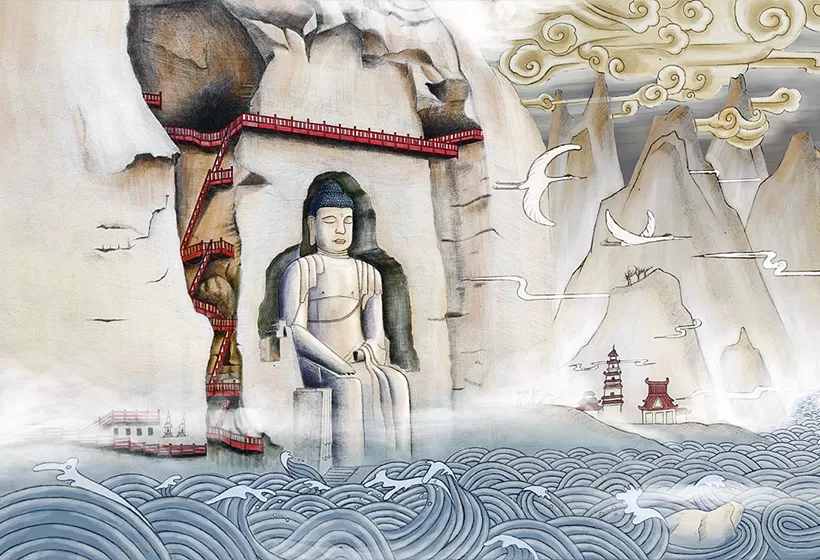Silk Roads: The Routes Network of Chang'an-Tian Shan Corridor
Introduction of the Silk Roads (2014)
The Silk Road placed on the World Heritage List includes 33 sites of three countries, including capital cities and palace complexes from various empires and Khan kingdoms, trading settlements, Buddhist cave temples, ancient paths, post houses, passes, beacon towers, sections of The Great Wall, fortifications, tombs and religious buildings. All these are a subtle look into the bustling town along the silk road.
The Silk Road stretches some 5,000 kilometers, including 33 listed cultural heritage sites. The total area was 42,680 square hectares, and the cultural heritage sites, along with the buffer areas, occupy a total area of 234,464 hectares. Among them, 22 listed sites (including archeological sites and ancient buildings) are in China, with 4 scattered along Henan Province, 7 in Shaanxi Province, 5 in Gansu Province and 6 in Xinjiang Uygur Autonomous Region. There are 8 listed sites in Kazakhstan and 3 in Kyrgyzstan.
Highlights
Due to the vast scale of the Silk Road project, the application was divided into four corridors to show the different geographic conditions, cultures and political systems, particularly Central China, Hexi Corridor North and South of Tianshan Mountains and Zhetysu Region, including 25 archeological sites, 3 historic buildings, 1 ancient tomb, and 4 cave temples.
Central China
On the fertile land of Central China are the 12 listed cultural heritage sites. It was there that China witnessed two powerful dynasties, the Qin and Han dynasties. The two thriving dynasties laid a solid foundation for the prosperity of successive dynasties for over 12 centuries. The city culture, Buddhist artifacts and nomadic culture of ethnic minorities was passed down from feudal dynasties as well as Zhang Qian’s westward expedition to current generations.An important diplomatic event is the highlight of this route. Listed below are the cultural heritage sites in this area:
- Luoyang City of the Eastern Han to Northern Wei Dynasty, Luoyang, Henan Province
- Dingding Gate, Luoyang City of the Sui and Tang Dynasty, Luoyang, Henan Province
- Longmen Grottoes (a preexisting World Heritage Site), Luoyang, Henan Province
- Hangu Pass, Lingbao, Henan Province
- Shihao section of Xiaohan Route, Xin'an County, Henan Province
- Weiyang Palace, Xi'an, Shaanxi Province
- Daming Palace, Xi'an, Shaanxi Province
- Giant Wild Goose Pagoda, Xi'an, Shaanxi Province
- Small Wild Goose Pagoda, Xi'an, Shaanxi Province
- Xingjiao Temple, Xi'an, Shaanxi Province
- Bin County Cave Temple, Bin County, Shaanxi Province
- Tomb of Zhang Qian, Chenggu County, Shaanxi Province
- Maijishan Cave Temple Complex, Tianshui, Gansu Province
Hexi Corridor
This corridor includes 5 cultural heritage sites. The uniquely designed cave temples are representative of the glory of border areas, said to be the best part of the Silk Road. There are fortresses and beacon towers that were used to guide travelers in the area as well as post houses used to provide accommodation for camel transport teams. Listed below are cultural heritage sites in this area:
- Bingling Cave Temple Complex, Yongjing County, Linxia Hui Autonomous Prefecture, Gansu Province
- Yumen Pass, Dunhuang, Gansu Province
- Xuanquanzhi Posthouse, Dunhuang, Gansu Province
- Mogao Caves (already inscribed on the World Heritage List), Dunhuang, Gansu Province
- Suoyang City Ruins, Anxi, Gansu Province
- North and South of Tianshan Mountains
This region includes 5 cultural heritages where countries were established by nomadic ethnic groups between the 2nd to 16th century. It was in the northern and southern corners of the Taklimakan Desert that Buddhism was introduced to China. Listed below are the cultural heritage sites in this area:
- Qocho (Gaochang) City Ruins, Turpan, Xinjiang Uyghur Autonomous Region
- Yar City Site of Bashbaliq City (Jiaohe Ruins), Turpan, Xinjiang Uyghur Autonomous Region
- Beshbalik City Ruins, Jimsar County, Xinjiang Uyghur Autonomous Region
- Kizil Gaha Beacon Tower, Kuqa, Xinjiang Uyghur Autonomous Region
- Kizil Caves, Kuqa, Xinjiang Uyghur Autonomous Region
- Subash Buddhist Temple Ruins, Kuqa, Xinjiang Uyghur Autonomous Region
Zhetysu Region
The cultural heritages in this region are strategic passes, which used to be important and some trading settlements. The highlights of this region include sandstone palaces and posthouses that are a testament to the local people’s shift from a nomadic lifestyle to settled agriculture and trade.
The Silk Road, stretching from Xi’an (called Chang’an in ancient times) to Roman, is an ancient trade route across the Afro-Eurasian landmass where Chinese silks were exported to countries through the Mediterranean region.
You might be interested in the Silk Road Tours
GREAT FAMILY CHINA TOUR
JULY 2024 We wanted to thank Grace at China Culture tour for organizing a great tour of China. We enjoyed our Beijing - Xian-Chengdu -Guilin -Yangshuo - Shanghai trip. Our local guides Bruce in Beijing, Susan in Xian, Jane in Chengdu, Mike in Guilin and Mary in Shanghai took care of us…read more details »
Teng Han L from SINGAPORE
Ready to Create a Unique Dream Travel?

